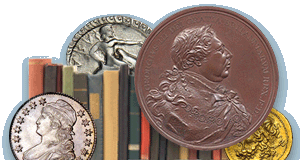|
PREV ARTICLE
NEXT ARTICLE
FULL ISSUE
PREV FULL ISSUE
The E-Sylum: Volume 3, Number 46, November 5, 2000, Article 10FILL IN THE <BLANK> COLLECTINGDick Johnson writes: "Collecting coin albums, cloth mint bags, bank deposit slips and other such peripheral money items is a tacit expression that we are moving away from our "core" interests. (I am never one to criticize what another collector assembles as I have gathered some esoteric items myself in the past, so I am not casting any stones from my glass house!). But aren't we numismatists moving in the wrong direction? Question: What one denominator is common to all coins, medals, tokens and paper money? What is the one basic CORE subject common to all numismatics? What should we know more about than any other in the field of numismatics (and perhaps don't)? Answer: Engraving. Yet how many books, articles, numismatic writing have you seen (ever!) on engraving? Shouldn't we be learning more about engraving as a precept for all numismatic understanding? Yet it is not easy researching engraving. I have talked with and interviewed both hand and machine engravers, those that worked for Medallic Art when I worked there also, and outside engravers. I learned a little about their tools and techniques but nothing about the history of engraving. Engravers are craftsmen that can carve a little metal but have little feeling for their heritage. One told me in his entire lifetime he found only one book on engraving; "But it was in German and I couldn't read it!" Most books on engraving discuss the flat engraving for printing. To distinguish this from die engraving for coins and medals some call this "die sinking." So I checked a number of websites recently for both terms: On eBay: no books, 3 pieces of equipment for die sinking, 3,625 entries on engraving. On Barns & Noble: 1 new book, 1 old on die sinking, 337 and 7,747 for engraving. On Yahoo: 9 entries on die sinking, 382 on engraving. On Abebooks: 1 on die sinking, 14,661 on engraving. On Google: 102,000 entries on die sinking, 239,000 on engraving. Not one book of numismatic interest! At ANS's Library Catalog I found 5 entries on die sinking: two on die sinking errors, one on Anglo-Saxon, one on Lauer -- a catalog from the German die sinking firm -- and one on artistic die sinking in 1898. I must admit I had read none of the articles (but do own two copies of the Lauer catalog listed, but do not consider this a source of information on numismatic die sinking). Point of all this: I am concerned where we are headed. Aren't we chasing a wider spreading ripple of peripheral artifacts of questionable value when we should become more knowledgeable about an important core interest, such as engraving? Is this the direction we want numismatics to go?" Wayne Homren, EditorContent presented in The E-Sylum is not necessarily researched or independently fact-checked, and views expressed do not necessarily represent those of the Numismatic Bibliomania Society. This is a static archive page documenting the originally published content. Links were active at the time of publication but may no longer work. Check subsequent issues for corrections and commentary. The Numismatic Bibliomania Society is a non-profit organization promoting numismatic literature. For more information please see our web site at http://www.coinbooks.org/ There is a membership application available on the web site. To join, print the application and return it with your check to the address printed on the application. Visit the Membership page. Those wishing to become new E-Sylum subscribers (or wishing to Unsubscribe) can go to the following web page link. To submit items for publication in The E-Sylum, write to the Editor at this address: E-Sylum Editor Copyright © 1998 - 2024 The Numismatic Bibliomania Society (NBS) |

